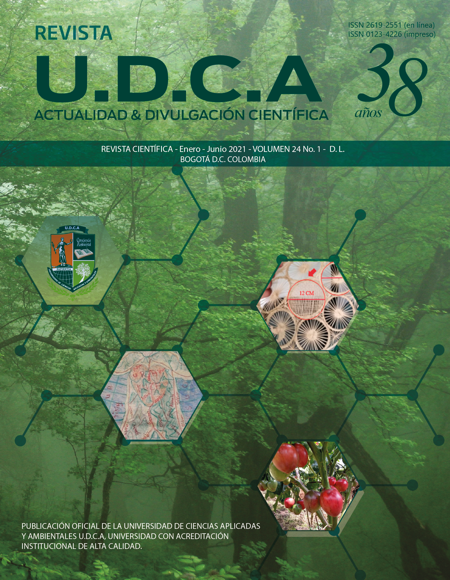Incidencia de hipotermia perioperatoria inadvertida, en perros sometidos a anestesia general inhalatoria
Incidence of inadvertent perioperatory hypothermia, in dogs submitted to inhalation general anesthesia
Contenido principal del artículo
Resumen
La incidencia de hipotermia perioperatoria inadvertida es una de las principales complicaciones perianestésicas en caninos. El objetivo del presente estudio fue evaluar la incidencia de hipotermia perioperatoria inadvertida en 49 perros sometidos a anestesia general inhalatoria. Al finalizar el periodo preanestésico, transanestésico y postanestésico, se registró la temperatura corporal, de acuerdo con los siguientes rangos: hipertermia (>39,5°C), normotermia (38,5-39,5°C), hipotermia leve (38,4-36,5°C), hipotermia moderada (36,4-34,0°C), hipotermia severa (<34°C). En preanestesia, el 65% de los animales mostraron hipotermia leve y 2% hipotermia moderada. En transanestesia, 55% de los animales tuvieron hipotermia leve, 37% hipotermia moderada y 6,1% hipotermia severa. En postanestesia, 59% de los animales tuvieron hipotermia leve, 29% hipotermia moderada y 6% hipotermia severa. Se encontraron diferencias al comparar la temperatura basal, con la final transanestésica y postanestésica, respectivamente (p<0,001); del mismo modo, se obtuvieron diferencias al comparar la temperatura inicial, con la final del periodo transanestésico (p<0,001). Por otra parte, no hubo relación estadística entre las diferentes clasificaciones ASA, los procedimientos realizados, el sexo y los rangos etarios evaluados, así como tampoco hubo diferencia en el tiempo de extubación frente al tipo de procedimiento realizado. Los resultados de este estudio sugieren que, bajo las condiciones aquí planteadas, la incidencia de hipotermia preanestésica es mínima, mientras la aparición de hipotermia transanestésica y postanestésica de carácter leve, moderada y severa es mayor.
Palabras clave:
Descargas
Datos de publicación
Perfil evaluadores/as N/D
Declaraciones de autoría
- Sociedad académica
- Universidad de Ciencias Aplicadas UDCA
- Editorial
- Universidad de Ciencias Aplicadas y Ambientales U.D.C.A
Detalles del artículo
Referencias (VER)
AARNES, T.K.; BEDNARSKI, R.M.; LERCHE, P.; HUBBELL, J.A.E. 2017. Effect of pre-warming on perioperative hypothermia and anesthetic recovery in small breed dogs undergoing ovariohysterectomy. Can. Vet. J. 58(2):175-179.
ÁLVAREZ-RESÉNDIZ, G.E.; OCHOA-GAITÁN, G.; VELAZCO-GONZÁLEZ, J.G.; GUTIÉRREZ-PORRAS, C.L.; MONARES-ZEPEDA, E. 2013. Monitoreo anestésico básico. Rev. Mex. Anest. 36(Supl 1):s95-s100.
BIAZZOTTO, C.B.; BRUDNIEWSKI, M.; SCHMIDT, A.P.; JUNIOR, J.O.C.A. 2006. Hipotermia no periodo perioperatório. Rev. Bras. Anestesiol. 56(1):89-106. http://doi.org/10.1590/S0034-70942006000100012
BINDU, B.; BINDRA, A.; RATH, G. 2017. Temperature management under general anesthesia: Compulsion or option. J. Anaesthesiol. Clin. Pharmacol. (India). 33(3):306-316. https://doi.org/10.4103/joacp.JOACP_334_16
BRODEUR, A.; WRIGHT, A.; CORTES, Y. 2017. Hypothermia and targeted temperature management in cats and dogs. J. Vet. Emerg. Crit. Care. (Reino Unido). 27(2):151-163. https://doi.org/10.1111/vec.12572
BURITICÁ, E.; ECHEVERRY, D.; OSPINA-ARGÜELLES, D.A. 2019. Efecto de dos maniobras cíclicas de reclutamiento alveolar sobre diversos parámetros de monitoreo microcirculatorio no invasivo en perros. Rev. U.D.C.A Act. & Div. Cient. (Colombia). 22(1):e1150. https://doi.org/10.31910/rudca.v22.n1.2019.1150
CASTILLO, C.G.; CANDIA, C.A.; MARROQUÍN, H.A.; AGUILAR, F.; BENAVIDES, J.J.; ÁLVAREZ, J.A. 2013. Manejo de la temperatura en el perioperatorio y frecuencia de hipotermia inadvertida en un hospital general. Rev. Colomb. Anestesiol. 41(2):97-103. https://doi.org/10.1016/j.rca.2013.03.002
CLARK-PRICE, S. 2015. Inadvertent perianesthetic hypothermia in small animal patients. Vet. Clin. North. Am. Small Anim. Pract. (Estados Unidos). 45(5):983-994. https://doi.org/10.1016/j.cvsm.2015.04.005
CLARKE, K.W.; TRIM, C.M.; HALL, L.W. 2014. Veterinary anesthesia. Ed. Saunders Elsevier (China). 694p.
DALE, H.E.; ELEFSON, E.E.; NIEMEYER, K.H. 1968. Influence of environmental temperature on recovery of dogs from pentobarbital anaesthesia. Am. J. Vet. Res. (Estados Unidos). 29(7):1339-1347.
DUKE, J.C. 2016. Temperature disturbances. En: Duke, J.C.; Keech, B.M. (Eds). Duke’s anesthesia secrets. Ed. Saunders Elsevier (Estados Unidos). p.177-180.
FERNANDES, L.A.; BRAZ, L.G.; KOGA, F.A.; KAKUDA, C.M.; MÓDOLO, N.S.; DE CARVALHO, L.R.; VIANNA, P.T.; BRAZ, J.R. 2012. Comparison of peri-operative core temperature in obese and non-obese patients. Anesthesia (Estados Unidos). 67(12):1364-1369. https://doi.org/10.1111/anae.12002.x
GRIMM, K.A. 2015. Perioperative thermoregulation and heat balance. En: GRIMM, K.A.; LAMONT, L.A.; TRANQUILLI, W.J.; GREENE, S.A.; ROBERTSON, S.A. (Eds). Veterinary anesthesia and analgesia -the fifth edition of Lumb and Jones. Ed. Wiley BlackWell (Estados Unidos). p.372-379.
GRUBB, T.; SAGER, J.; GAYNOR, J.S.; MONTGOMERY, E.; PARKER, J.A.; SHAFFORD, H.; TEARNEY, C. 2020. 2020 AAHA Anesthesia and Monitoring Guidelines for Dogs and Cats. J. Am. Anim. Hosp. Assoc. 56(2):59-82. https://doi.org/10.5326/JAAHA-MS-7055
HART, S.R.; BORDES, B.; HART, J.; CORSINO, D.; HARMON, D. 2011. Unintended perioperative hypothermia. Ochsner J. (Estados Unidos). 11(3):259-270.
MUIR, W.W.; HUBBELL, J.A.E.; BEDNARSKI, R.M.; LERCHE, P. 2013. Handbook of veterinary anesthesia. Ed. Elsevier Mosby (Estados Unidos). 600p.
ORTEGA, R.M. 2016. Hipotermia perioperatoria y su riesgo en el paciente quirúrgico. Vanguardia Veterinaria (México). 76:22-26.
PAWSON, P. 2008. Sedatives. En: Maddison, J.E.; Page, S.W.; Church, D.B. (eds). Small animal clinical pharmacology. Ed. Saunders Elsevier (China). p.113-125.
PORTIER, K.; IDA, K.K. 2018. The ASA physical status classification: what is the evidence for recommending its use in veterinary anesthesia?-A systematic review. Front. Vet. Sci. (Suiza). 5:204. https://doi.org/10.3389/fvets.2018.00204
POTTIE, R.G.; DART, C.M.; PERKINS, N.R.; HODGSON, D.R. 2007. Effect of hypothermia on recovery from general anaesthesia in the dog. Aust. Vet. J. 85(4):158-162. https://doi.org/10.1111/j.1751-0813.2007.00128.x
RILEY, C.; ANDRZEJOWSKI, J. 2018. Inadvertent perioperative hypothermia. BJA Educ. (Reino Unido). 18(8):227-233. https://doi.org/10.1016/j.bjae.2018.05.003
REDONDO, J.I.; SUESTA, P.; SERRA, I.; SOLER, C.; SOLER, G.; GIL, L.; GÓMEZ-VILLAMANDOS, R.J. 2012. Retrospective study of the prevalence of postanaesthetic hypothermia in dogs. Vet. Rec. (Reino Unido). 171(15):374. http://doi.org/10.1136/vr.100476
RODRIGUEZ-DIAZ, J.M.; HAYES, G.M.; BOESCH, J.; MARTIN-FLORES, M.; SUMNER, J.P.; HAYASHI, K.; MA, E.; TODHUNTER, R.J. 2019. Decreased incidence of perioperative inadvertent hypothermia and faster anesthesia recovery with increased environmental temperature: A nonrandomized controlled study. Vet. Surg. (Estados Unidos). 49(2):256-264. http://doi.org/10.1111/vsu.13328
SANJUÁN, M.; ABAD, E.M.; DE LA FLOR, M. 2011. Termorregulación y manejo perioperatorio. Cir. May. Amb. (España). 16(4):173-190.
STEPANIUK, K.; BROCK, N. 2008. Hypothermia and thermoregulation during anesthesia for the dental and oral surgery patient. J. Vet. Dent. (Estados Unidos). 25(4):279-83. https://doi.org/10.1177/089875640802500413
THOMAS, J.A.; LERCHE, P. 2017. Anesthesia and analgesia for veterinary technicians. Ed. Elsevier (Canadá). 445p.
YANG, L.; HUANG, C.Y.; ZHOU, Z.B.; WEN, Z.S.; ZHANG, G.R.; LIU, K.X.; HUANG, W.Q. 2015. Risk factors for hypothermia in patients under general anesthesia: Is there a drawback of laminar airflow operating rooms? A prospective cohort study. Int. J. Surg. (Holanda). 21:14-17. https://doi.org/10.1016/j.ijsu.2015.06.079
YI, J.; LEI, Y.; XU, S.; SI, Y.; LI, S.; XIA, Z.; SHI, Y.; GU, X.; YU, J.; XU, G.; GU, E.; YU, Y.; CHEN, Y.; JIA, H.; WANG, Y.; WANG, X.; CHAI, X.; JIN, X.; CHEN, J.; XU, M.; XIONG, J.; WANG, G.; LU, K.; YU, W.; LEI, W.; QIN, Z.; XIANG, J.; LI, L.; XIANG, Z; PAN, S.; ZHAN, L.; QIU, K.; YAO, M.; HUANG, Y. 2017. Intraoperative hypothermia and its clinical outcomes in patients undergoing general anesthesia: National study in China. PloS One (Estados Unidos). 12(6):1-13. https://doi.org/10.1371/journal.pone.0177221







